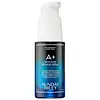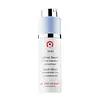What's inside
What's inside
 Key Ingredients
Key Ingredients

 Benefits
Benefits

 Concerns
Concerns

 Ingredients Side-by-side
Ingredients Side-by-side

Water
Skin ConditioningPropanediol
SolventDimethyl Isosorbide
SolventTriheptanoin
Skin ConditioningDimethicone
EmollientGlycerin
HumectantPentylene Glycol
Skin ConditioningHexyldecanol
EmollientDisiloxane
Skin ConditioningCetyl PEG/PPG-10/1 Dimethicone
EmulsifyingDiheptyl Succinate
EmollientPropylene Carbonate
SolventHydroxypinacolone Retinoate
Skin ConditioningPPG-24-Glycereth-24
EmulsifyingPhenyl Trimethicone
Skin ConditioningRetinol
Skin ConditioningUbiquinone
AntioxidantHoney Extract
HumectantSodium Hyaluronate Crosspolymer
HumectantAlgae Extract
EmollientZingiber Officinale Extract
Skin ConditioningOpuntia Ficus-Indica Fruit Extract
Skin ConditioningBisabolol
MaskingButyrospermum Parkii Butter
Skin ConditioningPhospholipids
Skin ConditioningSaccharomyces Cerevisiae Extract
Skin ConditioningLecithin
EmollientSodium Acrylates Copolymer
Hydrogenated Polyisobutene
Emollient1,2-Hexanediol
Skin Conditioning4-T-Butylcyclohexanol
MaskingPolyglyceryl-10 Stearate
Skin ConditioningCaprylyl Glycol
EmollientHelianthus Annuus Seed Oil
EmollientSorbitol
HumectantCetylhydroxyproline Palmitamide
Skin ConditioningPolysilicone-11
Benzoic Acid
MaskingDehydroacetic Acid
PreservativeSodium Phytate
Glyceryl Polyacrylate
Polysorbate 80
EmulsifyingHydroxyphenyl Propamidobenzoic Acid
Skin ConditioningStearic Acid
CleansingBrassica Campestris Sterols
EmollientPvp
Emulsion StabilisingCapryloyl Glycerin/Sebacic Acid Copolymer
Skin ConditioningSodium Benzoate
MaskingAlcohol
AntimicrobialPotassium Phosphate
BufferingDecyl Glucoside
CleansingPhenoxyethanol
PreservativeHexylene Glycol
EmulsifyingPotassium Sorbate
PreservativeTocopherol
AntioxidantWater, Propanediol, Dimethyl Isosorbide, Triheptanoin, Dimethicone, Glycerin, Pentylene Glycol, Hexyldecanol, Disiloxane, Cetyl PEG/PPG-10/1 Dimethicone, Diheptyl Succinate, Propylene Carbonate, Hydroxypinacolone Retinoate, PPG-24-Glycereth-24, Phenyl Trimethicone, Retinol, Ubiquinone, Honey Extract, Sodium Hyaluronate Crosspolymer, Algae Extract, Zingiber Officinale Extract, Opuntia Ficus-Indica Fruit Extract, Bisabolol, Butyrospermum Parkii Butter, Phospholipids, Saccharomyces Cerevisiae Extract, Lecithin, Sodium Acrylates Copolymer, Hydrogenated Polyisobutene, 1,2-Hexanediol, 4-T-Butylcyclohexanol, Polyglyceryl-10 Stearate, Caprylyl Glycol, Helianthus Annuus Seed Oil, Sorbitol, Cetylhydroxyproline Palmitamide, Polysilicone-11, Benzoic Acid, Dehydroacetic Acid, Sodium Phytate, Glyceryl Polyacrylate, Polysorbate 80, Hydroxyphenyl Propamidobenzoic Acid, Stearic Acid, Brassica Campestris Sterols, Pvp, Capryloyl Glycerin/Sebacic Acid Copolymer, Sodium Benzoate, Alcohol, Potassium Phosphate, Decyl Glucoside, Phenoxyethanol, Hexylene Glycol, Potassium Sorbate, Tocopherol
Water
Skin ConditioningPolysorbate 80
EmulsifyingCaprylic/Capric Triglyceride
MaskingPolysorbate 20
EmulsifyingButylene Glycol
HumectantPersea Gratissima Oil
Skin ConditioningGlycerin
HumectantDimethicone
EmollientRetinol
Skin ConditioningMagnesium Ascorbyl Phosphate
AntioxidantColloidal Oatmeal
AbsorbentTocopherol
AntioxidantHydrolyzed Hyaluronic Acid
HumectantCeramide NP
Skin ConditioningAcetyl Hexapeptide-8
HumectantLinoleic Acid
CleansingAllantoin
Skin ConditioningPhytosteryl Canola Glycerides
Skin ConditioningPalmitic Acid
EmollientOleic Acid
EmollientGlycine Soja Oil
EmollientHydroxypropyl Cyclodextrin
MaskingAloe Barbadensis Leaf Juice
Skin ConditioningTriolein
Skin ConditioningCaprylyl Glycol
EmollientAcrylates/C10-30 Alkyl Acrylate Crosspolymer
Emulsion StabilisingXanthan Gum
EmulsifyingLecithin
EmollientStearic Acid
CleansingMaltodextrin
AbsorbentBHT
AntioxidantBHA
AntioxidantPhenoxyethanol
PreservativeSodium Hydroxide
BufferingPotassium Sorbate
PreservativeWater, Polysorbate 80, Caprylic/Capric Triglyceride, Polysorbate 20, Butylene Glycol, Persea Gratissima Oil, Glycerin, Dimethicone, Retinol, Magnesium Ascorbyl Phosphate, Colloidal Oatmeal, Tocopherol, Hydrolyzed Hyaluronic Acid, Ceramide NP, Acetyl Hexapeptide-8, Linoleic Acid, Allantoin, Phytosteryl Canola Glycerides, Palmitic Acid, Oleic Acid, Glycine Soja Oil, Hydroxypropyl Cyclodextrin, Aloe Barbadensis Leaf Juice, Triolein, Caprylyl Glycol, Acrylates/C10-30 Alkyl Acrylate Crosspolymer, Xanthan Gum, Lecithin, Stearic Acid, Maltodextrin, BHT, BHA, Phenoxyethanol, Sodium Hydroxide, Potassium Sorbate
 Reviews
Reviews

Ingredients Explained
These ingredients are found in both products.
Ingredients higher up in an ingredient list are typically present in a larger amount.
Caprylyl Glycol is a humectant and emollient, meaning it attracts and preserves moisture.
It is a common ingredient in many products, especially those designed to hydrate skin. The primary benefits are retaining moisture, skin softening, and promoting a healthy skin barrier.
Though Caprylyl Glycol is an alcohol derived from fatty acids, it is not the kind that can dry out skin.
This ingredient is also used as a preservative to extend the life of products. It has slight antimicrobial properties.
Learn more about Caprylyl GlycolDimethicone is a type of synthetic silicone created from natural materials such as quartz.
What it does:
Dimethicone comes in different viscosities:
Depending on the viscosity, dimethicone has different properties.
Ingredients lists don't always show which type is used, so we recommend reaching out to the brand if you have questions about the viscosity.
This ingredient is unlikely to cause irritation because it does not get absorbed into skin. However, people with silicone allergies should be careful about using this ingredient.
Note: Dimethicone may contribute to pilling. This is because it is not oil or water soluble, so pilling may occur when layered with products. When mixed with heavy oils in a formula, the outcome is also quite greasy.
Learn more about DimethiconeGlycerin is already naturally found in your skin. It helps moisturize and protect your skin.
A study from 2016 found glycerin to be more effective as a humectant than AHAs and hyaluronic acid.
As a humectant, it helps the skin stay hydrated by pulling moisture to your skin. The low molecular weight of glycerin allows it to pull moisture into the deeper layers of your skin.
Hydrated skin improves your skin barrier; Your skin barrier helps protect against irritants and bacteria.
Glycerin has also been found to have antimicrobial and antiviral properties. Due to these properties, glycerin is often used in wound and burn treatments.
In cosmetics, glycerin is usually derived from plants such as soybean or palm. However, it can also be sourced from animals, such as tallow or animal fat.
This ingredient is organic, colorless, odorless, and non-toxic.
Glycerin is the name for this ingredient in American English. British English uses Glycerol/Glycerine.
Learn more about GlycerinLecithin is a term for a group of substances found in the cell membranes of plants, animals, and humans. They are made up of mixture of phospholipids.
This ingredient has emollient and emulsifying properties.
As an emollient, lecithen helps soften the skin and creates a barrier to keep moisture in.
As an emulsifier, it also helps prevent water and oil ingredients from separating. Lecithin can also help ingredients be better absorbed by the skin.
This is because the phospholipids in lecithin produce liposomes. Liposomes help other ingredients get through the skin barrier.
Depending on the source of this ingredient, lecithin may not be fungal acne safe. This is because some sources of lecithin come from soybean oil, which may feed the malassezia yeast that feeds fungal acne.
We recommend reaching out to the brand you are purchasing from to inquire about the source of their lecithin.
Some other names for this ingredient include soy lecithin and deoiled soy lecithin.
Learn more about LecithinPhenoxyethanol is a preservative that has germicide, antimicrobial, and aromatic properties. Studies show that phenoxyethanol can prevent microbial growth. By itself, it has a scent that is similar to that of a rose.
It's often used in formulations along with Caprylyl Glycol to preserve the shelf life of products.
Polysorbate 80 is a surfactant and emulsifier. It is used to keep ingredients together, and prevent oils and waters from separating.
It is made from polyethoxylated sorbitan and oleic acid. This ingredient can be found in cosmetics, foods, and medicine. It is water-soluble.
Polysorbate 80 may not be fungal acne safe.
Learn more about Polysorbate 80Potassium Sorbate is a preservative used to prevent yeast and mold in products. It is commonly found in both cosmetic and food products.
This ingredient comes from potassium salt derived from sorbic acid. Sorbic acid is a natural antibiotic and effective against fungus.
Both potassium sorbate and sorbic acid can be found in baked goods, cheeses, dried meats, dried fruit, ice cream, pickles, wine, yogurt, and more.
You'll often find this ingredient used with other preservatives.
Learn more about Potassium SorbateRetinol is a gold-standard ingredient for anti-aging. It is a form of Vitamin A and belongs to the class of retinoids that also includes tretinoin.
Why is retinol famous?
It has the most scientific studies backing up its skin benefits out of all the non-prescription ingredients.
Retinol is proven to:
This is why retinol is effective at removing wrinkles, fading dark spots, treating acne, and reducing the appearance of pores.
Studies show retinol is less effective when exposed to UV. Be sure to look for appropriate packaging to keep your retinol potent (similar to Vitamin C).
Using retinol or any retinoids will increase sun-sensitivity in the first few months. Though studies show retinoids increase your skin's natural SPF with continuous use, it is best to always wear sunscreen and sun-protection.
We recommend speaking with a medical professional about using this ingredient during pregnancy.
Retinol may cause irritation in some people, so be sure to patch test. Experts recommend 'ramping up' retinol use: start using this ingredient once a week and work up to using it daily.
Read about Tretinoin
Learn more about RetinolStearic Acid is a fatty acid. It is an emollient, emulsifier, and texture enhancer.
As an emollient, stearic acid helps soften skin. It aids the skin's protective barrier by preventing water loss. It also provides a gentle cleansing effect without stripping away natural oils.
Stearic acid may also be used to enhance the texture of products. It can add volume and stabilize ingredients such as water and oil. This can help water and oil ingredients from separating.
Sources of stearic acid include animal or vegetable fats/oils such as coconut or shea. It can be naturally found in butter, cocoa butter, shea butter, vegetable fats, and animal tallow.
This ingredient may not be Malassezia folliculitis, or fungal-acne safe.
Learn more about Stearic AcidTocopherol (also known as Vitamin E) is a common antioxidant used to help protect the skin from free-radicals and strengthen the skin barrier. It's also fat soluble - this means our skin is great at absorbing it.
Vitamin E also helps keep your natural skin lipids healthy. Your lipid skin barrier naturally consists of lipids, ceramides, and fatty acids. Vitamin E offers extra protection for your skin’s lipid barrier, keeping your skin healthy and nourished.
Another benefit is a bit of UV protection. Vitamin E helps reduce the damage caused by UVB rays. (It should not replace your sunscreen). Combining it with Vitamin C can decrease sunburned cells and hyperpigmentation after UV exposure.
You might have noticed Vitamin E + C often paired together. This is because it is great at stabilizing Vitamin C. Using the two together helps increase the effectiveness of both ingredients.
There are often claims that Vitamin E can reduce/prevent scarring, but these claims haven't been confirmed by scientific research.
Learn more about TocopherolWater. It's the most common cosmetic ingredient of all. You'll usually see it at the top of ingredient lists, meaning that it makes up the largest part of the product.
So why is it so popular? Water most often acts as a solvent - this means that it helps dissolve other ingredients into the formulation.
You'll also recognize water as that liquid we all need to stay alive. If you see this, drink a glass of water. Stay hydrated!
Learn more about Water